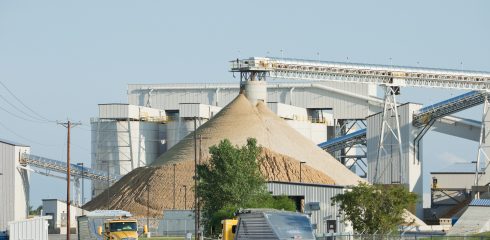
In any bulk material handling system, it is critical to be able to convey material from point A to point B as well as feed material out of a bin or hopper. Often times, the terms feeder and conveyor are used interchangeably without much thought given to their function and design requirements.
A feeder is the means by which the rate of material from a bin¹ or hopper² is controlled. When a feeder stops, material flow should stop as well. When a feeder is turned on, there should be a close correlation between its speed of operation and the rate of discharge of the bulk material. Examples of feeders include a belt feeder for coal, a vibratory pan feeder for applying seasoning to chips, and an apron feeder for ore under a stockpile.
Mechanical conveyors are used to transport bulk materials but, unlike feeders, they are incapable of modulating the rate of material flow. Examples of conveyors include a drag-chain conveyor for hot clinker, a screw conveyor for limestone, and a belt conveyor to take ore from a primary to a secondary crusher.
The main difference between a feeder and a conveyor is that feeders are flood-loaded while conveyors are not. Also, while conveyors typically operate at a constant speed, feeders are always capable of varying the speed of operation. As a result, feeders are capable of modulating the discharge rate from the vessel that is flood loading it.
These differences are summarized in Table 1 below.
|
Table 1: Summary of differences between feeders and conveyors |
||
|
Attribute |
Feeder |
Conveyor |
|
Mode of operation |
100% full |
Partially full |
|
Speed of operation |
Variable, relatively low speeds |
Fixed, relatively high speeds |
|
Capable of rate control |
Yes |
No |
Dischargers are sometimes used to encourage material to flow out of a bin and, like feeders, they are flood-loaded. However, a discharger is neither a feeder nor a conveyor since it cannot modulate the discharge rate from the vessel that is flood loading it. An example of a discharger is a vibratory bin activator used for powdered soap.
Contact us to receive our recent article on this subject published by RUD Australia.





